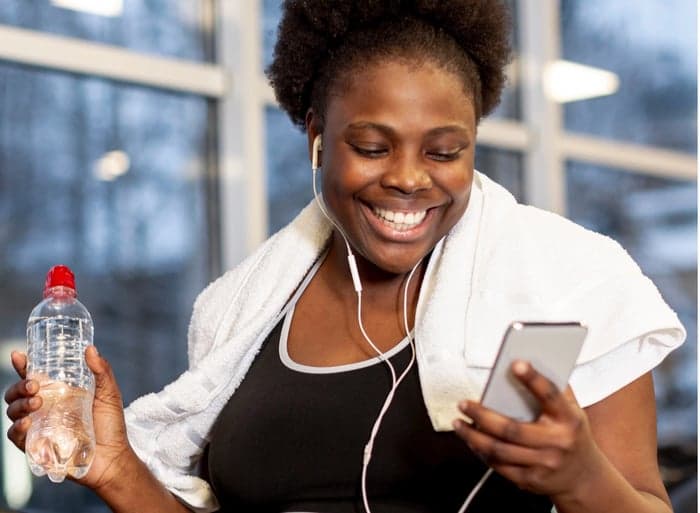
8 Mobility Apps That Will Improve Your Range of Motion
Table of Contents
- What Is Mobility Training (And Why You Need an App for It)
- The Best Mobility Apps Compared
- Ready to Roll Out Your Mat?
- 2. Pliability — Best for Performance-focused Athletes
- 3. Bend — Best Free Option
- 4. PhysiApp — Best for Injury Recovery
- 5. DownDog — Best Customizable + Beginner-Friendly Option
- 6. GOWOD — Best for Personalization for Athletes
- 7. SilverSneakers GO — Best for Seniors
- 8. The Movement Athlete — Best for Callisthenics
- How to Choose a Mobility App
- Which Mobility App Is Right For You?
- How to Stay Consistent With Mobility Training
- Conclusion
- Frequently Asked Questions
If you feel stiff after a long day of work, are recovering from an injury, or just want to move better without tension, mobility training can make all the difference. But it’s not easy to find an app that fits your current level of mobility. Some apps feel too generic or advanced, while others don’t show real progress.
Below, we’ve reviewed the best mobility training apps of 2025, tested for different needs, including injury recovery, daily movement, limited mobility, and overall wellness. Whether you’re an office worker, senior, beginner, or athlete, you’ll surely find an app that fits your body and lifestyle. You’ll also learn how to choose one that you can use to build consistency, recover faster, and finally move without pain.
Short on time? Here are the top mobility apps at a glance:
Yogaia — Best for All-Around Mobility and Daily Consistency
Pliability — Best for Performance-focused Athletes
Bend — Best Free Option
PhysiApp — Best for Injury Recovery
DownDog — Best Customizable + Beginner-Friendly Option
GOWOD — Best for Personalization for Athletes
SilverSneakers GO — Best for Seniors
The Movement Athlete — Best for Callisthenics
What Is Mobility Training (And Why You Need an App for It)
Mobility training helps your joints, muscles, and nervous system work together so you can move freely without stiffness, strain, or pain. It allows you to bend down to tie your shoelaces, lift weights at the gym, or reach overhead to grab something off a high shelf without risk of injury. In short, mobility exercises improve your range of motion, motor control, and overall movement quality.
Mobility apps make it easy to access these exercises even if you don't have a gym membership, a coach, or special equipment. They blend science-based mobility routines with guided video instruction, progress tracking, and modification options for all fitness levels. This guide covers different types of mobility apps, such as:
Stretching and flexibility apps: Great for beginners or anyone easing everyday stiffness. They combine dynamic and static stretching for improved flexibility.
Athletic mobility apps: Ideal for gym-goers and athletes working on performance, recovery, or injury prevention.
Therapeutic or wellness-focused apps: Best for restoring balance, reducing pain, or improving mind-body coordination.
Once you know your current fitness level and goal, it’s easier to pick the app that meets your needs.
The Best Mobility Apps Compared
1. Yogaia — Best for All-Around Mobility and Daily Consistency
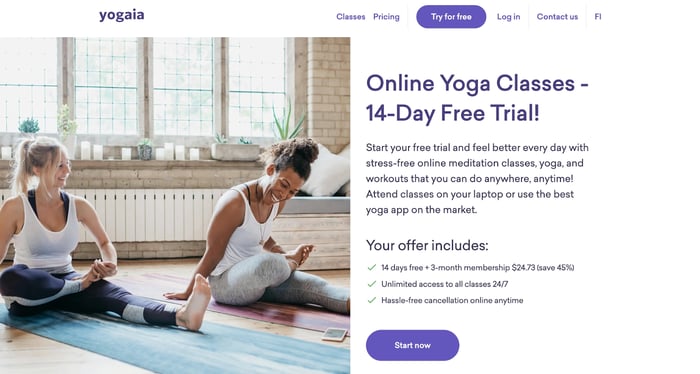
If you care about moving your whole body regardless of your age or level of experience, Yogaia is the app for you. Unlike many mobility apps that assume you’re already flexible or have a strict workout routine, Yogaia meets you where you are. You can select your preferred class difficulty from beginner to advanced and customize session lengths, from 5-minute quick stretches to hour-long sessions.
Yogaia offers a wide range of classes for everyone: from beginner-friendly stretching routines to chair yoga for seniors or those with limited joint mobility, and HIIT classes for a more intense burn. There are also targeted Mobility classes for the hips, neck, shoulders, and back that help you melt away tension in those areas.
With daily self-care nudges and class reminders, Yogaia is like a personal accountability coach in your pocket, making habit-building effortless.
Why Users Love Yogaia
Live Camera Opt-In: Join live classes with the option to have instructors see you and give feedback. It's like having a real studio experience right at home.
Pre-Recorded Library: A huge on-demand library lets you practice anytime, with multiple class types to choose from.
Habit Features: Designed for everyday users, Yogaia helps you build a consistent movement habit with weekly class scheduling and daily reminders.
Accessibility: Can be used on your mobile phone (iOS or Android), iPad, or Apple TV.
For Everyone: Classes are tailored to different levels of experience, from beginner to intermediate and advanced levels.
Cons:
Limited offline, which makes it harder to use when the internet is slow or unavailable.
Pricing:
Free Trial: 14 days of unlimited access
Monthly: $19.99/month
Annual: $119.88/year.
Special Deal: $24.73 for a 3-month period
Ready to Roll Out Your Mat?
Start your own online yoga journey today with Yogaia. No pressure, no commute—just calm, connection, and convenience.
2. Pliability — Best for Performance-focused Athletes

As an athlete who trains hard, whether it’s CrossFit, running, or heavy Olympic lifts, you already know how much tight joints and poor range of motion can hold you back. That’s where Pliability (formerly ROMWOD) comes in. It’s a performance-focused mobility training app designed to help you move better, recover faster, and prevent injuries through intelligent, sport-specific mobility programs.
Right as you sign up, the app offers you a Mobility Test that uses your camera to analyze how your body moves. In under 3 minutes, it identifies problem areas, like stiff hips, tight shoulders, or other areas with limited joint mobility, and creates a custom program based on your mobility goals.
Once you're in, you’ll find daily mobility exercises tailored for your training style, whether you’re preparing for a CrossFit session, unwinding after a long run, or improving shoulder stability for weightlifting. Each video walks you through dynamic stretching exercises and active recovery techniques for injury prevention and improved range of motion.
Why Users Love Pliability
Personalized mobility programs based on real movement data
High-quality videos and expert instruction
Routines for recovery, performance, and flexibility training
Sport-specific options (CrossFit, golf, running, etc.)
Combines mobility, breathing, and mindfulness
Cons:
No live feedback, social community, or trainer chat, which makes motivation harder for some users.
Pricing
Free Trial: 7-day full access
Monthly: $17.95/month
Annual: $179/year (save two months)
Discounts available for military and first responders
If running is part of your routine, our yoga for runners guide will help improve your endurance and reduce the risk of injury.
3. Bend — Best Free Option
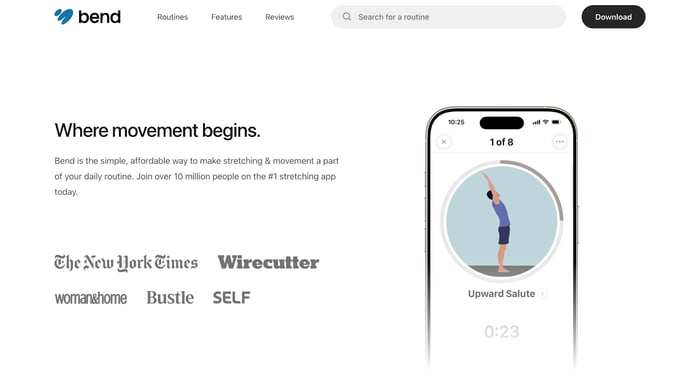
If you’re starting your mobility journey and want something simple at no cost, Bend might be exactly what you need. One of the most popular fitness apps, it makes daily mobility and stretching so easy to follow that you actually want to stay consistent.
Bend’s clean, visual design shows each mobility program step by step, complete with countdown timers and gentle audio cues. You can choose between short 4-minute flows or full-body 30-minute sessions, depending on your schedule or how tight your body feels that day.
Most users start with free routines like Wake Up, Posture Reset, and Sleep Stretch, which target everyday pain points from desk work, stress, or poor posture. Over time, as your range of motion improves, you can progress to deeper stretches and more advanced sequences.
Why Users Love Bend
Clean, beginner-friendly interface with intuitive features.
Great free library of stretching and mobility workouts.
Smooth experience on any mobile device, works offline.
Focused on functional movement and better posture.
Ideal for daily mobility habits without subscriptions.
Cons:
No community or instructor feedback to correct your posture.
Some users find the basic routine in the app's free version somewhat limited.
Pricing
Free: Access to basic daily essentials (Wake Up, Posture Reset, Sleep Stretch).
Premium: $13.99/month or $39.99/year for personalized routines and advanced plans.
4. PhysiApp — Best for Injury Recovery
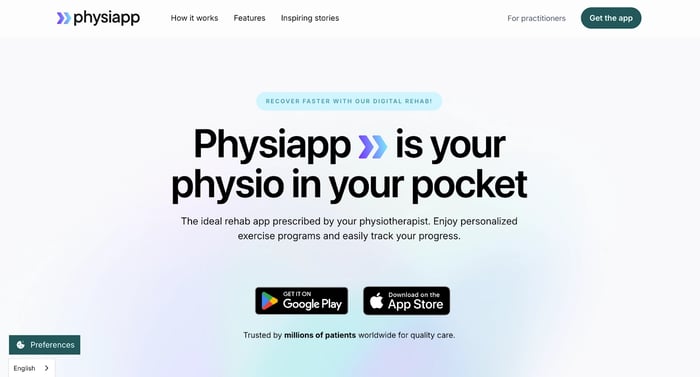
For someone looking to incorporate at-home workouts to support safe recovery from surgery and injuries, the PhysiApp is highly recommended. It pairs with Physitrack, a trusted platform used by over 15,000 clinicians and 2,000+ healthcare organizations worldwide.
Once your physiotherapist gives you a unique access code, you can log in to view HD video demonstrations with voice guidance, follow personalized mobility exercises, and track your pain levels or progress directly from the app. Everything you do syncs back to your clinician—so they can monitor your recovery and adjust your plan in real time.
In a nutshell, PhysiApp turns traditional home rehab into an interactive, data-backed recovery journey, helping patients stay consistent and confident throughout the healing process.
Why Users Love PhysiApp
Every program is prescribed and adjusted by a licensed clinician.
Each exercise includes HD visuals of professionals showing you how to move and breathe.
Built-in progress tracking where you and your physician can see your logged results.
Gentle streak reminders and progress milestones make recovery feel rewarding.
Accessible on mobile phone (iOS & Android) and web.
Cons:
Requires a therapist’s access code to access workouts.
Delayed clinic feedback can stall your self-guided routines.
Pricing:
For patients: Completely free to use for patients under a professional's guidance.
For clinicians: Physiotherapists require a subscription fee starting from $21.99/month (USD) or $237 annually.
Want to improve your lower body mobility at home? These leg mobility exercises can help you see real progress.
5. DownDog — Best Customizable + Beginner-Friendly Option
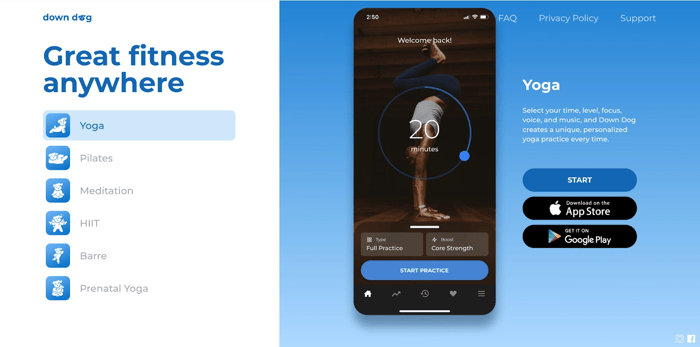
For anyone looking for a mobility training app with doable, unintimidating routines, DownDog is a good pick. Whether you’re brand new to yoga or easing back into movement, it delivers a studio-quality experience that's highly customizable, too.
On DownDog, no two sessions are ever the same, as the app pulls from over 60,000 yoga combinations to create unique flows tailored to your needs. You can choose from multiple class styles like Vinyasa, Hatha, Yin, Restorative, Gentle, or even Chair Yoga — whatever matches your mood.
Why Users Love DownDog
Perfectly paced beginner levels that build confidence and mobility.
With over 60,000 possible flows, no two sessions are alike.
Easy customization by length, intensity, focus, and voice.
Affordable pricing with generous seasonal discounts.
Available offline and across multiple devices and languages.
Cons:
No live instructor feedback or built-in community.
Pricing:
Monthly: $9.99/month
Annual: $59.99/year (discounted to $7.99/month or $39.99/year via website)
Free version: Limited access available
Special offers: Student, teacher, and holiday discounts—sometimes as low as $25/year
6. GOWOD — Best for Personalization for Athletes
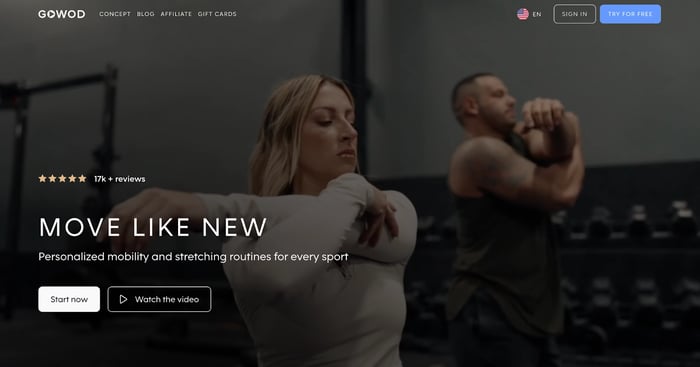
If you’ve ever wished your mobility routine could feel as tailored as your training program, GOWOD might be exactly what you’ve been missing. It’s one of the most data-driven and customizable mobility apps out there. Originally focused on mobility exercises for athletes, it’s surprisingly intuitive for anyone who wants to move better in their daily life.
The app starts with a 10-part mobility test that evaluates your flexibility in key areas, such as the hips, shoulders, and spine. You’ll get a detailed Mobility Profile, and from there, the app creates daily mobility routines, warmups, and recovery sessions that evolve as you do.
The magic of GOWOD lies in its personalization. Every program adapts to your weakest areas and tight spots. Over time, your profile updates automatically, helping you track measurable progress in flexibility and movement efficiency.
Why Users Love GOWOD
Personalized mobility exercise routines built around user data.
Visual dashboards let you track improvements in the range of motion.
Structured and distinct pre-workout, recovery, and daily sessions.
Over 50 sports are covered, from trail running to jiu-jitsu.
Cons:
Daily flows can get repetitive without rotating focus areas.
Pricing:
Free: Includes the initial mobility test and limited access to daily flows.
Premium: $11.99/month or $59.99/6 months or $107.99/year
All plans include a 14-day free trial.
7. SilverSneakers GO — Best for Seniors
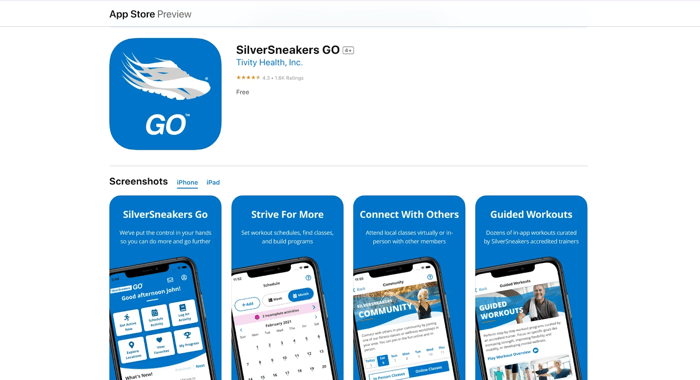
Staying active as you age shouldn’t feel complicated, and that’s exactly what SilverSneakers GO gets right. Designed specifically for older adults, this app blends mobility training, gentle strength training, and mindfulness into one easy, senior-friendly experience.
SilverSneakers program gives you access to an entire wellness network—live and on-demand classes, certified instructors, and over 15,000 partner gyms—all from your phone. Whether you’re at home, outdoors, or in a fitness center, you can move confidently at your own pace.
Why Users Love SilverSneakers Go
200+ workouts across mobility, chair yoga, stretching, strength, balance, and meditation.
Customizable programs for your fitness level, mobility needs, and comfort zone—from fully seated to light standing routines.
Easy scheduling and progress tracking to help you stay consistent and motivated.
Specialized walking and low-impact cardio plans to build endurance safely, without stressing your joints.
Cons:
Access to the unlimited class library and gym scheduling features requires a valid SilverSneakers ID.
It may feel too basic for advanced users or active seniors.
Pricing:
Free: Seniors under Medicare Advantage or Medigap plans can access all the app features for free. However, non-members can download the app and enjoy a limited number of free workout videos.
For some more senior-focused mobility apps, check out our guide on the best yoga apps for seniors.
8. The Movement Athlete — Best for Callisthenics
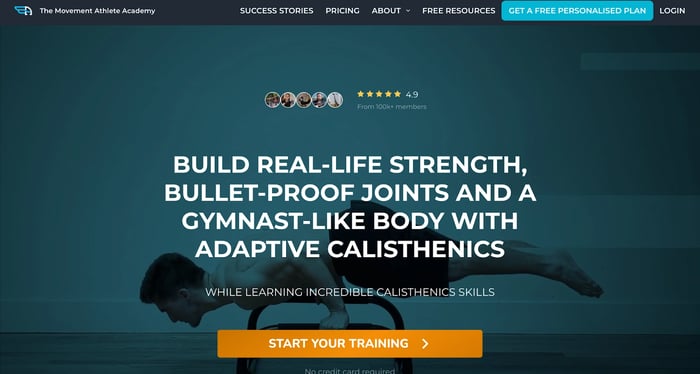
If you’ve ever wanted to master your body through movement without depending on weights or gym machines, The Movement Athlete is your app. Built around callisthenics, mobility, and bodyweight strength, it helps users unlock functional fitness skills like handstands, planches, and muscle-ups while improving flexibility, balance, and control.
What sets this app apart is its personalized progression system. Instead of generic workout plans, The Movement Athlete assesses your current mobility and strength level through an interactive test and builds a tailored mobility training plan that adapts as you improve.
Before every workout, you’ll complete joint-prep and flexibility routines designed to protect your shoulders, hips, and spine. Whether you’re a total beginner or already active, these sessions improve your range of motion and stability, helping you perform bodyweight movements with better control.
Why Users Love The Movement Athlete
Excellent offline access for outdoor or home-based workouts.
Skill-based progression makes callisthenics goals (like handstands or muscle-ups) achievable.
Feedback loop ensures exercises adapt to your real-time performance.
Continuous progress tracking and analytics create visible motivation that keeps you going.
Cons:
The learning curve can be steep for users new to callisthenics.
Workouts can feel solitary because there are no live classes or community features.
Pricing:
Free trial: 7-day free trial
Monthly: $24.97/ month
Quarterly: $49.97/quarter
Annual: $157/year
One-time payment: $497
How to Choose a Mobility App
With so many options on the market, the best mobility app for you depends on your mobility goals, whether that’s improved flexibility, recovery, or better daily movement. Here’s what to consider before committing to a mobility app subscription:
Align With Your Goals
Start by identifying your desired goals. Are you aiming to improve athletic performance with mobility exercises, or move more freely in your daily life with light stretching? If you’re an athlete or gym-goer, apps like GOWOD offer mobility programs that enhance your entire range of motion and joint strength. If you’re more interested in easing everyday tension, a mobility and stretching app like Yogaia, which offers gentle, guided mobility programs, might be all you need.
Live Guidance vs. Self-Driven Practice
Some apps offer real-time sessions, like having a virtual mobility coach, while others rely on pre-recorded mobility routines you can follow at your own pace. If you thrive on structure and accountability, choose an app with instructor-led sessions. Prefer independence? A stretching app with self-guided videos might be your best fit.
Personalization and Progress Tracking
A good app adapts to your needs. Look out for an app that caters to your activity level and tracks your progress. Also, prioritize class variety. Choose an app that gives you enough variety to match how your body feels each day. Some days you might need an intense mobility workout; other days, gentle recovery work. That balance helps you improve steadily without hitting a plateau.
Safety and Modifications
If you’re recovering from injury or have limited joint mobility, choose apps that include modifications and dynamic stretching exercises designed for pain-free progress. Some also include short mobility exercise routines to warm up or cool down, helping reduce the risk of injury and improve your coordination skills.
Pricing and Access
Finally, consider your budget and lifestyle. Many apps offer a free trial or limited plan before you commit to a mobility app subscription. If you travel often or prefer flexible access, check for offline modes so you can continue your mobility training anytime, anywhere—from your mobile device or tablet.
Which Mobility App Is Right For You?
Here’s a quick decision guide to help you choose:
Want instructor-led guidance?
Try Yogaia. It’s the best all-around mobility app for beginners and everyday users who want live or on-demand classes with real-time feedback.
Training like an athlete?
GOWOD and Pliability are top athletic mobility apps offering personalized mobility tests, performance tracking, and recovery programs.
Looking for senior-friendly mobility training?
SilverSneakers Go and Yogaia provide gentle, low-impact mobility workouts for older adults.
Just starting your mobility journey?
Bend, Down Dog, and Yogaia offer beginner-friendly mobility exercises and short daily routines to build consistency.
Prefer a free mobility app?
Bend and GOWOD both include free mobility programs and flexibility tests you can use without a paid plan.
Interested in bodyweight or callisthenics-style mobility training?
The Movement Athlete helps you improve joint mobility, control, and overall strength through bodyweight exercises.
How to Stay Consistent With Mobility Training
The biggest challenge isn’t always finding the best mobility app; it’s sticking with it. Even the most effective mobility routine won’t work unless you stay consistent. Apps like Yogaia, Bend, and Pliability make this easier with daily reminders, progress tracking, and short, doable routines that fit into any schedule.
If you want to build consistently and make mobility training part of your lifestyle, here are some tips you can follow:
Start Small, But Stay Frequent
You don’t need hour-long sessions to see results. 5-10 minutes a day, or even two to three short sessions a week, can make a noticeable difference in your flexibility and movement quality. The truth is, short, consistent sessions do far more for your mobility than occasional long ones.
Set Reminders
If you often forget or have a packed schedule, reminders can make all the difference. Apps like Yogaia let you choose how often you want to train — any number of times a week — and send gentle nudges when it’s time to move. You can also set your own alerts on your phone or calendar. The key is to schedule them at realistic times so you’re less likely to hit “ignore.” Over time, these reminders train your brain to expect movement as part of your daily rhythm, and it becomes second nature.
Pair Mobility With Existing Habits
The best way to make mobility training stick is to tie it to something you already do. You can do a 5-minute stretch before you brush your teeth in the morning. Or schedule a 10-minute mobility routine before you wind down for the evening. Habit stacking makes you associate one habit you can’t do without daily with a new one you are trying to form (mobility training). It helps your brain warm up to the new habit more easily.
Celebrate Your Wins (No Matter How Small)
Mobility progress can be subtle, so make sure to notice it. Maybe you can now twist your upper body without stiffness or get up from the floor without using your hands. These moments are proof that your consistency is paying off, and recognizing them keeps you motivated to continue.
Conclusion
Mobility training isn’t just for elite athletes. It’s for anyone who wants to move better, feel stronger, and maintain a healthy range of motion at any age or fitness level. Whether you’re building strength through callisthenics or restoring balance and flexibility, the right mobility program can transform the way your body feels and performs.
With consistent dynamic stretching exercises, joint mobility work, and the help of top-rated mobility apps, you’ll unlock an excellent degree of mobility and confidence in your everyday movement.
Want to start today? Check out Yogaia’s gentle, daily-updated mobility routines and see how even a few minutes of focused movement can bring lasting freedom and ease to your body.
Frequently Asked Questions
Are mobility apps worth it?
Yes, mobility apps are absolutely worth it if you want structured, consistent support for improving flexibility, strength, and joint mobility. Unlike random YouTube routines, top apps like Yogaia, Pliability, and others offer guided, evidence-based mobility training developed by movement experts and coaches. You can access tailored mobility programs, daily reminders, and clear tracking — all of which make it easier to stay consistent and see measurable results over time.
What is the best mobility app?
The “best” mobility app really depends on your goals, fitness level, and training style:
For performance-focused athletes: Pliability and GOWOD lead the pack with mobility testing, recovery flows, and CrossFit-friendly structures.
For beginners or daily wellness: Yogaia and Down Dog are packed with easy, instructor-led mobility and yoga routines.
For injury recovery or rehab support: PhysiApp connects you with licensed professionals for safe, trackable rehabilitation.
For active older adults: SilverSneakers GO stands out with accessible, low-impact workouts built to improve balance, mobility, and longevity.
Each of these provides guided mobility coaching, so your best pick depends on your lifestyle and mobility goals.
Is there a totally free exercise app for seniors?
Yes. SilverSneakers GO is a reputable free fitness app for older adults, available at no cost to users in the United States under the Medicare Advantage health insurance plan. It includes hundreds of joint-safe, senior-specific workouts — from chair yoga and balance exercises to walking programs — all designed to support mobility and independence.
Is there a good free mobility app?
Yes, there are. While premium subscriptions unlock more content, the free tiers of apps like Bend and GOWOD still offer high-quality mobility routines. You can also explore free trials on apps like Yogaia to access the whole library of mobility routines for the first 14 days.
